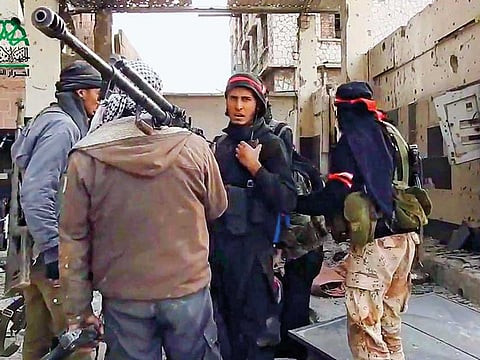Ghouta battle likely to be long and bloody
Thousands of well-armed rebel fighters are in Ghouta the last major opposition-controlled area near Damascus

Beirut: The Syrian government’s battle to recapture the rebel-held eastern suburbs of Damascus is likely to be a long and bloody fight because of the presence of thousands of battle-hardened fighters who have had years to prepare.
Many of the fighters entrenched in eastern Ghouta are originally from the area and move around using an elaborate network of underground tunnels, giving them an advantage against President Bashar Al Assad’s forces and their Russian- and Iranian-backed allies.
The territory of some 400,000 residents is the last major opposition-controlled area near Al Assad’s seat of power, and the rebels have been targeting the capital with volleys of mortar shells, disrupting life in a reminder that they can deprive the city of peace as the government, backed by Russia, rains down bombs and carnage on the besieged area.
If government forces retake eastern Ghouta, only one small pocket south of the capital held by Daesh will remain out of government control.
Among the more than 20,000 fighters in eastern Ghouta, a few hundred belong to the Al Qaida-linked Levant Liberation Committee, giving the government a pretext to continue with its assault. Rebel factions want the Al Qaida-linked fighters to leave and blame the government for preventing it.
In a letter on Monday to UN Secretary General Antonio Guterres, the three main rebel factions in eastern Ghouta said they were committed to making Al Qaida-linked fighters and their families leave within 15 days.
An official with one of the most powerful groups, the Army of Islam, said that if the Al Qaida-linked fighters don’t leave or abandon the fight, “all options” are open against them, including the use of force.
Here is a look at the rebel groups involved in the battle for eastern Ghouta
Jaish Al Islam
One of the most powerful rebel factions in Syria, the Army of Islam is backed by Saudi Arabia and adheres to the ultraconservative Salafi ideology of Islam. It was founded by Zahran Alloush, who was in prison for anti-government activities and adopting a hard-line Islamist ideology when the uprising against Al Assad began in March 2011. He was released months later.
Since the rise of Daesh in 2014, the Army of Islam has repeatedly clashed with the extremists, as well as with Al Qaida-linked fighters.
A Jaish Al Islam fighter fires artillery in Deraa, Syria. AP
The group is headquartered in the town of Douma, the most populated area in eastern Ghouta.
The group started with a small number of fighters soon after protests in Syria turned into an armed insurgency, and grew under Alloush to an estimated 10,000 fighters armed with tanks, armored personnel carriers, artillery and mortars.
Alloush was killed in an air strike in eastern Ghouta on Christmas Day 2015 that was blamed on Russia.
Abu Ammar Dalwan, the Army of Islam’s political chief, vowed in an interview with The Associated Press to fight until the end. “We will not negotiate to leave Ghouta,” he said.
The Army of Islam is taking part in UN-sponsored peace talks in Geneva, as well as negotiations in the Kazakh capital of Astana sponsored by Russia, Iran and Turkey.
Fayluq Al Rahman
Fayluq Al Rahman, or Al Rahman Corps, is the second-largest rebel group in eastern Ghouta after Army of Islam. Backed by Turkey and Qatar, it controls most of the central parts of the region, including the towns of Arbeen, Kfar Batna, Saqba and Hammouriyeh, which have been among the hardest hit in recent fighting. The group also controls parts of the Damascus neighborhood of Jobar.
The group has about 8,000 fighters, the vast majority of them from eastern Ghouta.
Fayluq Al Rahman fighters fire weapons during clashes in the suburbs of Damascus. AP
Like the Army of Islam, it is well-armed, and a video released recently showed it has primitive factories that produce mortar shells and rocket-propelled-grenades.
The group’s military commander, Abdul Nasser Shmeir, is a former captain of the Syrian army. The group is also taking part in the peace talks in Geneva and Astana.
Ahrar Al Sham
Ahrar Al Sham has been involved in deadly battles against fighters of the Al Qaida-linked Levant Liberation Committee in the northern province of Idlib and Aleppo.
Although at the start of their rise the group adopted an extreme ideology, now it markets itself as a moderate rebel group. In eastern Ghouta, it has a strong presence in the Damascus suburb of Harasta and nearby areas.
Months after the uprising against Al Assad’s government began in March 2011, Ahrar Al Sham was founded by several Islamists, including Mohammad Baheya, who had links to Al Qaida leader Ayman Al Zawahri. Baheya reportedly fought against US troops in Afghanistan and Iraq.
Baheya was killed in a suicide bombing in 2014 while trying to mediate between Daesh and the Al Qaida-linked Nusra Front. Ahrar Al Sham survived its most serious blow in September 2014, when an explosion in Idlib province killed some of its top figures, including its leader, Hassane Abboud.
Tahrir Al Sham
Tahrir Al Sham rejects any peace talks with the government and because of its ties to Al Qaida is considered a terror organisation by the United Nations.
It has about 600 fighters in eastern Ghouta, a small number compared to the estimated 20,000 rebel fighters in the area.
Since the end of 2017, there have been on-and-off negotiations to try to evacuate the Al Qaida-linked fighters and their families from eastern Ghouta, but the rebels say Al Assad’s government has frustrated all such attempts as a pretext to keep attacking the area.
Sign up for the Daily Briefing
Get the latest news and updates straight to your inbox



